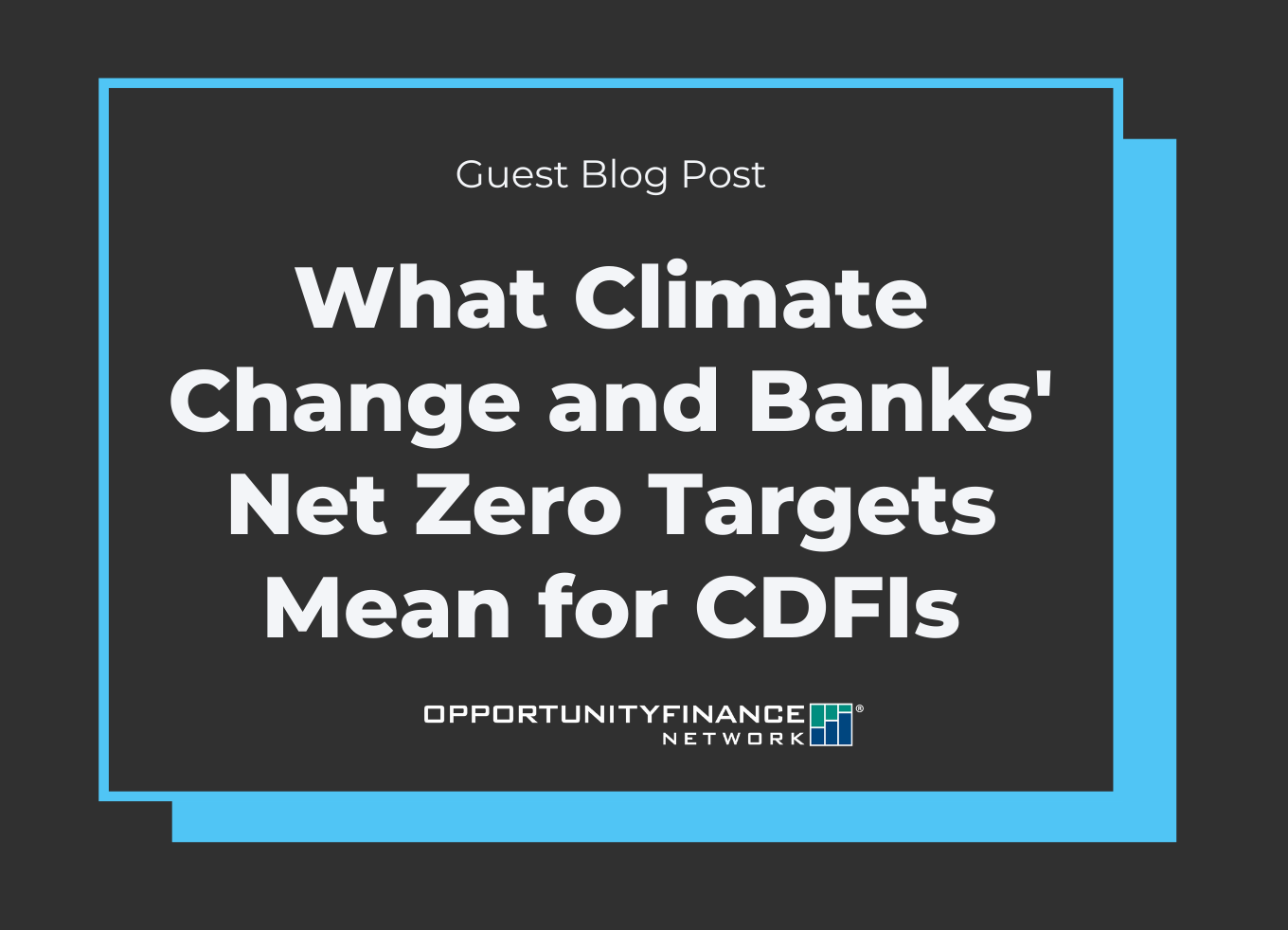
What Climate Change and Banks’ Net Zero Targets Mean for CDFIs
Jen Leybovich, Laurie Schoeman, Amy Brusiloff, and Melissa Malkin-Weber
Community Development Financial Institutions (CDFIs) have been a leader in addressing economic and racial inequities for decades. As we see climate change more adversely impacting many of our underserved and most vulnerable communities, this is an important opportunity for CDFIs to come to the forefront and be part of the solution, helping to build more sustainable communities.
As a changing climate brings more erratic weather, and more serious economic impacts in the communities that CDFIs serve, it is critical that these organizations are part of the solution – helping to support low-carbon opportunities through deployment of capital, reduce risks associated with climate change, advance equity and equality, and address environmental justice issues. The communities most vulnerable to the climate emergency are those that CDFIs have been dedicated to supporting for decades. Addressing the impacts of a changing climate is vital to the well-being of the communities we serve, work, and live in.
Environmental justice and reducing risks associated with climate change must be considered in the deployment of financial resources as we work to build more climate resilient and sustainable communities. Many CDFIs and community development stakeholders are already making progress with some important groundwork in this arena, including:
- Developing a resilience assessment tool for CDFI lending programs;
- Building and delivering solar finance training courses;
- Creating a CDFI carbon accounting guide; and
- Forming an ad-hoc CDFI Climate Crisis Working Group (CCWG) to learn and share lessons.
This groundwork is complemented by a growing institutional movement to address climate change. Examples of this movement include such things as the proposed Securities and Exchange Commission rule on climate-related disclosure, inclusion of climate risk in proposed changes to the Community Reinvestment Act, and the Justice40 commitment by the federal government. In addition, the private sector banks have joined the momentum as well, which will have ripple effects for the CDFI industry. Many banks have commitments to reach net zero by 2050.
Bank of America, a major financial supporter of CDFIs, recently shared with the CDFI Climate Crisis Working Group the company’s long-standing commitment to the environment and the critical work it is focused on to address climate-related issues. Bank of America met its carbon neutrality goal in 2019, a year ahead of schedule, and in 2021 set its net zero before 2050 commitment for its financing activities, operations, and supply chain. This commitment includes CDFIs, which will also need to be net zero by 2050. Bank of America, a global financial institution, has announced its emission reduction targets to be achieved by year 2030 for three key sectors in its portfolio. Targets for clients in other sectors, including CDFIs, will follow.
“It is critical that we scale financing in an effort to accelerate low-carbon business activities and climate resilience solutions in all our communities. From an environmental justice perspective, it is important that our most vulnerable communities are not left behind.”
Amy Brusiloff, Community Development executive at Bank of America
What will CDFIs need to do?
To meet investors’ net zero goals, CDFIs will need to build capacity to address their direct carbon footprints – the greenhouse gas emissions attributable to their offices and travel. The tools linked at the bottom of this post are a great starting point.
More ambitiously, CDFIs must engage borrowers to seek energy efficiency and carbon reduction opportunities. The first priority for technical assistance should be clients that represent the greatest opportunity to help reduce emissions.
Borrower engagement in energy efficiency and clean energy needs to happen in tandem with crucial engagement on management plans for intensified climate risks. Private and public sector organizations and networks like Opportunity Finance Network (OFN), Natural Resources Defense Council, Enterprise Community Partners, and First Street have developed open-source tools to support climate risk reduction and advance climate resilience while reducing environmental and economic burden on vulnerable communities.
Meeting these challenges will require strategic and effective collaboration across public and private sectors. Partnerships will be needed to deliver comprehensive technical assistance at the predevelopment stage. For example, energy efficiency and solar-plus-battery implementation is most conducive when worked into the original mechanical designs and floor plans.
Many CDFIs do not have the internal capacity to develop climate disclosure plans or frameworks, which is why it will be necessary for CDFIs to leverage new and existing resources and support each other. Leveraging resources can also resolve issues of limited time or resources to address climate issues, and for this reason is strongly encouraged, as this work is too critical to ignore.
The CDFI Climate Crisis Working Group will continue to share lessons and strategies, and CDFI leaders in the space will continue to innovate – we invite all CDFIs to join this growing and imperative movement.
The CDFI Climate Crisis Working Group is a volunteer group of practitioners who gather monthly to learn from each other and find solutions that benefit the low-wealth communities we serve. Discussion, documents and archives are posted on the CDFI Connect Forum, hosted by Opportunity Finance Network. To be added to the email list, contact Jen Leybovich or Melissa Malkin-Weber.
This post was written by members of the CCWG: Jen Leybovich (Chief Development Officer, Main Street Launch), Laurie Schoeman (Director, Climate and Sustainability Enterprise Community Partners-Capital), Amy Brusiloff, (Community Development executive, Bank of America), and Melissa Malkin-Weber (Sustainability Director at Self-Help Credit Union & Ventures Fund).
Resources:
Carbon Disclosures How-To
- The Greenhouse Gas Accounting Protocol
- EPA’s Simplified GHG Emissions Calculator
- Sample CDFI PCAF Disclosure from CEI
Resources about Operationalizing Resilience into CDFI Lending
- Climate Safe Housing | Strategies for Multifamily Building Resilience
- Portfolio Protect | Enterprise Community Partners
- For more information on the Resilient Community Development Finance Initiative, including downloadable versions of the Resilience Assessment Tool for CDFI lending programs and Implementation Guide, see the Center for Impact Finance’s Financing Equitable Resilience.
